Colour Cosmetics Market Overview for 2025 to 2035
The colour cosmetics market is experiencing robust growth, supported by evolving beauty standards, the influence of social media, and the increasing demand for natural and sustainable products. Consumers are gravitating toward cosmetics formulated with organic ingredients, reflecting heightened awareness of skin health and environmental impact.
The market is characterized by strong innovation in texture, pigmentation, and multifunctional products that enhance user experience. Rising disposable incomes and expanding urban populations are driving the adoption of premium cosmetic brands.
Digital engagement through influencer-led marketing and virtual try-on technologies has also expanded brand reach. Future growth is anticipated to be driven by continued product diversification, sustainable packaging, and the integration of skincare benefits into color formulations, creating a convergence of beauty and wellness.
Quick Stats for Colour Cosmetics Market
- Colour Cosmetics Market Industry Value (2025): USD 57.3 Billion
- Colour Cosmetics Market Forecast Value (2035): USD 91.6 Billion
- Colour Cosmetics Market Forecast CAGR: 4.8%
- Leading Segment in Colour Cosmetics Market in 2025: Natural & Organic (64.3%)
- Key Growth Region in Colour Cosmetics Market: North America, Asia-Pacific, Europe
- Top Key Players in Colour Cosmetics Market: L’Oréal S.A., Chanel, Dior, Givenchy, Kroylan Professional Make-up, Lancôme, Mamaearth, TOM FORD S.A., Plum, Coty Inc., MAYBELLINE New York, Yves Saint Laurent, PAC Cosmetics, Revlon Group, NYX Professional Makeup, Shiseido Company
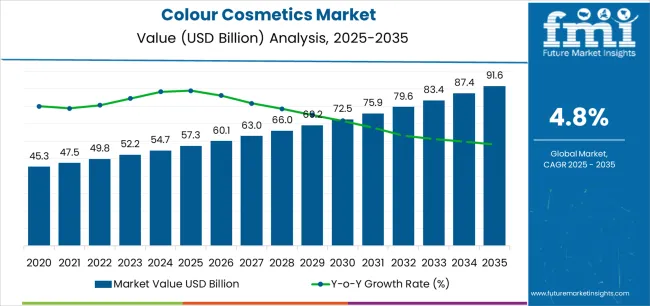
| Metric |
Value |
| Colour Cosmetics Market Estimated Value in (2025 E) |
USD 57.3 Billion |
| Colour Cosmetics Market Forecast Value in (2035 F) |
USD 91.6 Billion |
| Forecast CAGR (2025 to 2035) |
4.8% |
Segmental Analysis
The market is segmented by Product Type, Prices, Product Category, and Distribution Channel and region. By Product Type, the market is divided into Natural & Organic and Chemical. In terms of Prices, the market is classified into Premium and Economic. Based on Product Category, the market is segmented into Facial Makeup, Nail Products, Eye Makeup, Lip Products, Hair Colour Products, and Special Effects Products. By Distribution Channel, the market is divided into e-Commerce, Hypermarkets/Hypermarkets, Convenience Stores, Specialty Stores, and Direct Selling. Regionally, the market is classified into North America, Latin America, Western Europe, Eastern Europe, Balkan & Baltic Countries, Russia & Belarus, Central Asia, East Asia, South Asia & Pacific, and the Middle East & Africa.
Insights into the Natural & Organic Segment
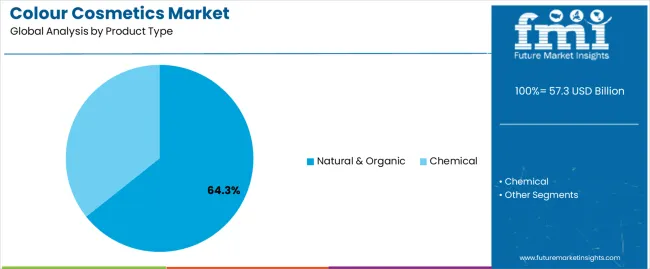
The natural and organic segment leads the product type category, accounting for approximately 64.3% share. This dominance reflects the growing consumer inclination toward clean, toxin-free cosmetics that combine beauty enhancement with skin health preservation.
Demand for plant-derived pigments and cruelty-free formulations has driven product innovation in this segment. Brands are investing heavily in certifications and transparent ingredient sourcing to strengthen consumer trust.
The segment’s rise is reinforced by alignment with sustainability values and lifestyle wellness trends. With increasing regulatory support for natural cosmetics and growing awareness of long-term skin benefits, the natural and organic segment is expected to sustain its lead across global markets.
Insights into the Premium Segment
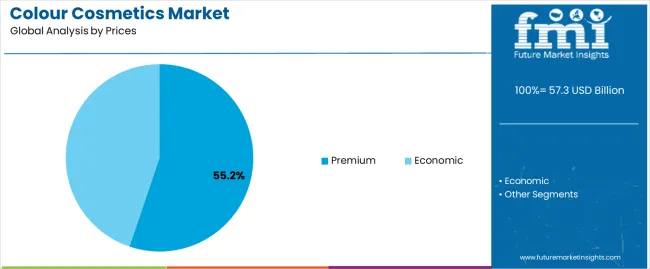
The premium segment accounts for approximately 55.2% share of the price category, driven by rising consumer willingness to invest in high-quality formulations offering enhanced performance and ethical value. Premium products are associated with superior textures, lasting finishes, and luxury packaging, appealing to aspirational consumers.
Expansion of organized retail, specialty beauty stores, and online luxury platforms has improved accessibility. The segment also benefits from the proliferation of influencer endorsements and limited-edition collections, which strengthen brand positioning.
As personalization and exclusivity gain prominence, premium color cosmetics are expected to remain a key revenue generator in the industry.
Insights into the Facial Makeup Segment
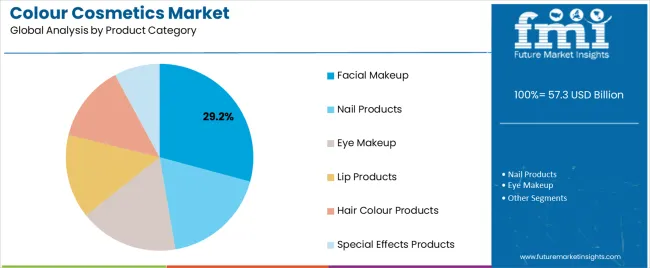
The facial makeup segment holds approximately 29.2% share of the product category, supported by consistent demand for foundations, primers, and concealers that align with varying skin tones and preferences. The segment benefits from technological advancements in formulation that enhance coverage and skin compatibility.
Hybrid products combining skincare benefits, such as hydration and sun protection, have further strengthened its appeal. Facial makeup also remains central to consumer routines across both daily wear and professional use.
With increasing inclusivity in shade ranges and innovation in lightweight, breathable textures, the segment is projected to maintain strong market presence.
Colour Cosmetics Market Size, Analysis, and Insights
- The growth of the fashion industry has contributed to the growth of the colour cosmetics market.
- The fashion industry is constantly evolving, and new trends are emerging every season. Evolution resulted in the launch of new cosmetic products that cater to the changing needs of consumers.
- As an increasing number of working women joining the workforce, the need for cosmetics catering to their needs is growing. Currently, women are looking for products that are long-lasting, easy to use, and provide a flawless finish, which increases the demand for colour cosmetics.
- The rise of eCommerce platforms has made it easier for consumers to access a wide range of cosmetic products from the comfort of their homes.
- The platforms lead to an increase in competition among cosmetic brands, which has resulted in the launch of new and innovative products at competitive prices.
- The rise in disposable income across the globe has LED to an increase in purchasing power, which has increased the demand for cosmetics.
- The growing popularity of social media platforms leads to an increase in the awareness of beauty products, which has further fueled the demand for colour cosmetics.
Key Opportunities in the Colour Cosmetics Market
- Organic products present an opportunity for manufacturers to invest in research and development of natural products. Consumers are becoming increasingly aware of the harmful chemicals used in cosmetics and are shifting toward organic and natural products.
- E-commerce has revolutionized the way consumers shop for cosmetics. Manufacturers can leverage this trend by creating their own eCommerce platforms or by partnering with popular eCommerce platforms to reach a wider audience.
- Consumers are looking for products that serve multiple purposes. Manufacturers can capitalize on this trend by creating products that offer a variety of benefits, such as moisturizing, sun protection, and anti-aging creams.
- Increasing demand for personalized products is expected to create significant opportunities during the forecast period.
- The growing trend toward men’s cosmetics is presenting an opportunity for manufacturers to create products specifically targeted towards men.
Challenges in the Colour Cosmetics Market
- Rapidly changing consumer preferences and trends are expected to hamper the market over the forecast period.
- With consumers becoming more conscious about the ingredients used in their cosmetics, manufacturers need to ensure that their products are safe, effective, and meet high ethical standards.
- Manufacturers need to keep the prices of their products competitive while maintaining high-quality standards, which can be difficult when production costs are increasing.
- Brand loyalty is another challenge in the color cosmetics market. With so many options available, consumers can be fickle and easily swayed by new and trendy products.
- Regulatory compliance is a significant challenge for manufacturers.
- The color cosmetics market is heavily regulated, and manufacturers need to comply with various safety and quality standards. Maintaining safety and quality standards is a time-consuming and costly process, but it is crucial for ensuring the safety of consumers and building trust in the brand.
Category-wise Insights
The Natural and Organic Segment Dominates the Market by Product Type
| Attributes |
Details |
| Top Product Type |
Natural and organic |
| Market share in 2025 |
64.3% |
- The increasing awareness and demand for clean and sustainable beauty products are driving the segment’s growth.
- Consumers are becoming more conscious of the ingredients used in their cosmetics and are actively seeking products made from natural and organic ingredients that are free from harmful chemicals.
- The trend towards natural and organic cosmetics is not limited to a particular region or market. This trend is gaining traction globally, with consumers in both developed and developing countries showing a growing preference for natural and organic products.
- The growing popularity of eCommerce platforms drives the demand for natural and organic products, which makes it easier for consumers to access a wide variety of natural and organic cosmetics.
The eCommerce Segment Dominates the Market by Distribution Channel
| Attributes |
Details |
| Top Distribution Channel |
E-commerce |
| Market CAGR in 2025 |
31.8% |
- The rise in internet penetration and smartphone usage has made it easier for customers to browse and purchase products online.
- Changing consumer preferences. With an increasing focus on health and wellness, many consumers are looking for ways to incorporate exercise into their daily routines.
- E-commerce platforms have made it easier for customers to compare prices and read reviews, which has resulted in increased popularity of e commerce platforms.
Country-wise insights
| Countries |
CAGR through 2035 |
| United States |
3.7% |
| United Kingdom |
4.1% |
| China |
7.4% |
| Japan |
5.5% |
| Australia |
6.8% |
Growing Trend of Social Media Fueling the Beauty Industry in the United States
- The growing trend of social media and the beauty industry's influence on it has LED to an increased awareness of beauty products among consumers in the United States.
- The rising disposable income of consumers has enabled them to spend more on premium makeup brands.
- The United States color cosmetics market is one of the largest and most mature markets globally.
- The demand for color cosmetics is higher in urban areas than in rural areas in the United States. Consumers in cities are more aware of beauty trends and willing to spend more on premium products.
- The market is also highly influenced by seasonal trends, with consumers purchasing products based on the latest fashion trends in the United States.
Strong Demand for Premium and Luxury Makeup Products in the United Kingdom
- There is a strong demand for premium and luxury makeup products in the United Kingdom.
- The increasing diversity of the population in the United Kingdom has LED to a greater demand for a wider range of makeup shades that cater to different skin tones.
- The rise of social media platforms and beauty influencers has LED to a greater focus on appearance and beauty trends among consumers in the United Kingdom.
- The growing diversity of the population in the UK has LED to a greater demand for a wider range of makeup shades that cater to different skin tones.
Rise in Disposable Income of Chinese Consumers
- There has been a significant rise in disposable income among Chinese consumers, which has LED to an increase in purchasing power.
- The rise of social media platforms has played a major role in promoting cosmetic products in China, especially among the younger generation.
- Growing demand for premium and high-quality products in the Chinese market, with consumers willing to pay a premium for quality and efficacy. This trend is expected to continue in the coming years, with more consumers seeking out high-end products.
Long Tradition of Valuing Beauty and Skincare in Japan
- The country has a long tradition of valuing beauty and skincare which leads to a high demand for cosmetics among Japanese consumers.
- The growing trend of "beauty from within” such as “wabi-sabi”. This refers to the idea that beauty is not just about external appearance but also about overall health and wellness. Japanese consumers are increasingly interested in cosmetics that not only make them look good but also have health benefits such as anti-aging properties or UV protection.
- The rise of social media and influencer marketing. Japanese consumers are highly active on social media platforms such as Instagram and YouTube, and they are influenced by beauty bloggers and influencers who promote the latest cosmetics products.
Growing Awareness among Consumers about the Importance of Personal Grooming in South Korea
- The growing awareness among consumers about the importance of personal grooming and appearance. Australians are becoming more interested in looking good and feeling confident, and color cosmetics are an important part of this trend.
- The cosmetics industry in Australia has been expanding rapidly, with new brands and products regularly entering the market. There is increased competition and innovation, which has further fueled the demand for color cosmetics.
- The rise of social media has played a significant role in promoting the use of color cosmetics, as influencers and celebrities showcase their makeup looks and trends to millions of followers.
Competitive Landscape
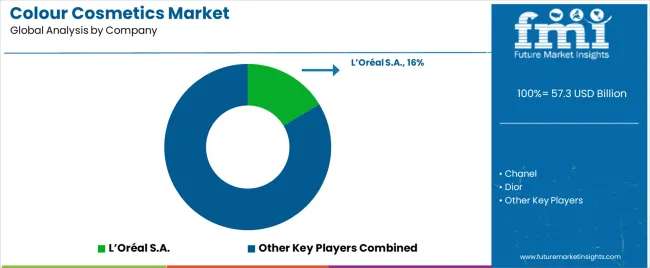
The market is constantly evolving, with new brands entering the market and established players introducing new products to stay ahead of the competition. Companies are competing on factors such as product quality, innovation, brand recognition, and pricing.
Additionally, the rise of e-commerce has made it easier for new players to enter the market and compete with established brands. Overall, the colour cosmetics market is highly competitive, with companies constantly striving to offer the best products and win over consumers.
Recent Developments
- In 2025, Revlon opened a new brand location in Delhi, India, which offers an immersive and experiential shopping experience for customers. The store features the full range of Revlon color cosmetics, skincare, and personal care products, as well as select Revlon Professionals and Street Wear Products. In addition to its product offerings, the flagship store provides a range of hair and makeover services, including hair coloring with the Revlon Professional line, hair care, hair cutting, and hair styling, as well as party makeovers and basic grooming, all performed by expert professionals.
Key Market Players
- Chanel
- Dior
- Givenchy
- L'Oréal S.A.
- Kroylan Professional Make-up
- Lancôme
- Mamaearth
- TOM FORD S.A.
- Plum
- Coty Inc.
- MAYBELLINE New York
- Yves Saint Laurent
- PAC Cosmetics
- Revlon Group
- NYX Professional Makeup
- Shiseido Company
- Sephora
- Rimmel London
- Laura Mercier
- Julep Beauty
Key Coverage in the Colour Cosmetics Market Report
- Beauty Industry Market Landscape
- Makeup Products Strategies Assessment
- Cosmetic Brands Sales Outlook
- global forum of colour cosmetics Analysis
- Cosmetic Products Pricing Scenario
Key Market Segments
By Product Type:
- Chemical
- Natural & Organic
By Prices:
By Product Category:
- Nail Products
- Facial Makeup
- Eye Makeup
- Lip Products
- Hair Colour Products
- Special Effects Products
By Distribution Channel:
- Hypermarkets/Supermarkets
- Convenience Stores
- Specialty Stores
- Direct Selling
- e-Commerce
By Region:
- North America
- Latin America
- East Asia
- South Asia
- Europe
- Oceania
- MEA
Frequently Asked Questions
How big is the colour cosmetics market in 2025?
The global colour cosmetics market is estimated to be valued at USD 57.3 billion in 2025.
What will be the size of colour cosmetics market in 2035?
The market size for the colour cosmetics market is projected to reach USD 91.6 billion by 2035.
How much will be the colour cosmetics market growth between 2025 and 2035?
The colour cosmetics market is expected to grow at a 4.8% CAGR between 2025 and 2035.
What are the key product types in the colour cosmetics market?
The key product types in colour cosmetics market are natural & organic and chemical.
Which prices segment to contribute significant share in the colour cosmetics market in 2025?
In terms of prices, premium segment to command 55.2% share in the colour cosmetics market in 2025.











